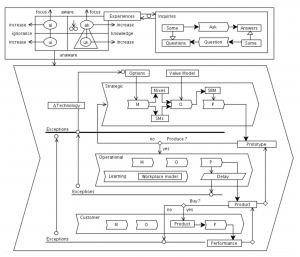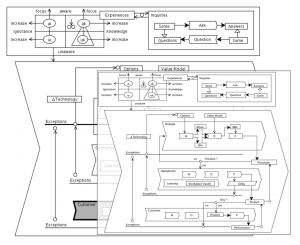This page is a sub-page of our page on Business Algebra.
///////
The sub-pages of this page are:
///////
The EE(S+O+C)(M+O+P) model:
NOTATION: EE(S+O+C)(M+O+P) =
(Enquire Experience)(Strategic+Operational+Customer)(Mix+Optimize+P),
where
P = Prototype (at the Strategic level),
P = Produce (at the Operational level), and
P = Perform (at the Customer level).
The EE(S+O+C)(M+O+P) model represents an attempt to model a larger context within which the EMEMO (Experience Mix Experience Match Optimize) model and the TELLME platform can be positioned. It has its roots in PROLEARN D5.3 and PROLEARN D1.10, and has taken on increased importance in TELL ME due to the feedback of the reviewers.
The PLPF (Professional Learning Process Framework) of PROLEARN D1.10 delinearized the traditional SECI-model of Nonaka by “breaking out” the EI loop of Externalization and Internalization) which goes on all the time. The activities (and attention) of this loop were then distributed across the parallel processes of C and S (Combination and Socialization) but which could just as well be interpreted as explicit and tacit, formal and informal, conscious and subconscious, etc, …).
In a similar way, the EE(S+O+C)(M+O+P) model delinearizes the EMEMO model by breaking out the EE (Enquire Experience) loop, which goes on all the time, and which guides and controls the other processes by distributing its corresponding attention/comprehension across the (Strategic + Operational + Customer) activities of a company X. Moreover, each of these levels are then addressed by a (Mix + Optimize + P) process, where the P stands for Prototype at the Strategic level, Produce at the Operational level, and Perform at the Customer level of company X.
Aware and unaware knowledge and ignorance
An experience \, Exp \, can be regarded as consisting of four different parts:
• Aware Knowledge
• Unaware Knowledge
• Aware Ignorance
• Unaware Ignorance
• Increase aware ignorance: Increase what we are aware that we don’t know.
• Increase unaware ignorance: Increase what we are unaware that we don’t know.
• Increase aware knowledge: Increase what we are aware that we know.
• Increase unaware knowledge: Increase what we are unaware that we know.
When we learn to do anything new – learning to drive for example – we go through three stages: The first stage demands a lot of attention as we try out the controls, learn the rules of driving, and so on. In the second stage we begin to coordinate our knowledge, linking movements together and more fluidly combining our actions with our knowledge of the car, the situation, and the rules. In the third stage we drive the car with barely a thought. It’s automatic. And with that our improvement at driving slows dramatically, eventually stopping completely.
By contrast, great performers never allow themselves to reach the automatic, arrested development stage in their chosen field. That is the effect of continual deliberate practice – avoiding automaticity. The essence of practice, which is constantly trying to achieve the things one cannot do comfortably, makes automatic behaviour impossible. […] Avoiding automaticity through continual practice is another way of saying that great performers are always getting better. [Colvin (2008), p. 82-83]
Exceptions at the Strategic, Operational and Customer levels
When something does not turn out as expected it must be possible to raise an exception, and preferably to learn from it. This is the bases of the Learn-Err model described in (Naeve, 2013).
Exceptions should be able to interact between the different levels (S+O+C). The “delay example” discussed in a sub-page of this page is an illustration of that. It is modeled on a real world case from the development of the Ericsson AXE-10 switchboard.
Iterativity of the model:
In a world of increasing transparency it becomes increasingly important to model larger and larger parts of the value graphs (= value-creating processes) that a company is involved in. For example, in order to encourage the loyalty of its customers, it is important for a company to model not only its customers but also its customers’ customers – in order to support its customers in creating value for their customers. At the opposite side of the value chain, it is important for the company to model not only its suppliers but also its suppliers’ suppliers, in order, for example, to be prepared – and therefore able to be proactive – when child labour is discovered somewhere further down the value chain.
The iterativity of the EE(S+O+C)(M+O+P) model caters to this need. Figure 10 shows an icon of the detailed map attached to the “Customer” process. As can be seen, this map is identical to the map we are linking from, which models the repetitive character of iteration.
The recursiveness of the model is based on the recursive aggregate structure of modules (Figure 6). This can be described in terms of dis-aggregation, as discussed in section 2.5.4 and section 30.4.

